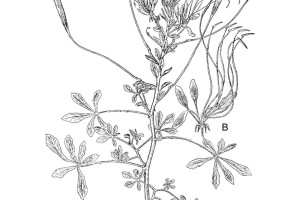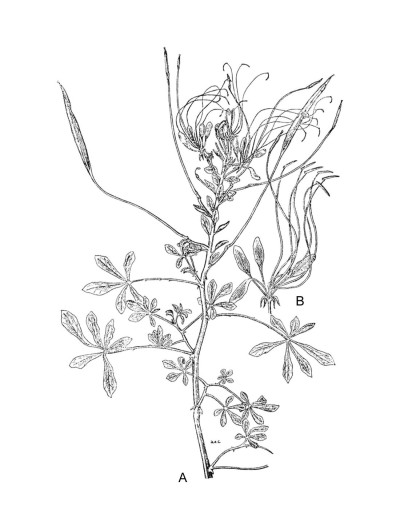Descripcion
Subarbustos de 1,5 m de alto; ramas glandular-pubescentes. Hojas con pecíolos de 3-8,5 cm de largo, glandular-pubescentes, armados con espinas rectas, delgadas o gruesas; espinas estipulares de 1,5-5 × 2-2,5 mm, ligeramente curvadas en el ápice; peciólulos de 1-3 mm de largo, armados, pubescentes; láminas 5-7 folioladas, folíolos obovados a oblanceolados, de 2,8-5 × 1,2-2,2 cm, basalmente cuneados, apicalmente obtuso apiculados, ambas caras con tricomas eglandulares cortos dispersos, nervadura central y venas secundarias densamente pubescentes, ciliados, sin espinas. Inflorescencia en racimos corimbiformes, de 15 cm de largo, terminales; brácteas con pecíolos pubescentes, de 2-5 mm de largo, con un par de espinas en la base y lámina ovada, de 11-17 × 6-14 mm, basalmente redondeada, apicalmente obtusa, ambas caras con tricomas eglandulares cortos dispersos, ciliada. Flores con pedicelos de 20-30 mm de largo, pubescente; sépalos lanceolados, de 8-9 × 1-2 mm, acuminados, pubescentes abaxialmente, ciliado; pétalos oblongo-elípticos, de 30-33 × 8-12 mm, basalmente contraídos en una garra de 15-18 mm de largo, apicalmente obtusos, glabros, blancos; nectario cónico, carnoso, discreto, obsoleto en el fruto; filamentos estaminales de 95-110 mm de largo, violáceos, anteras de 12-13 mm de largo; ovario cilíndrico, de 7-10 mm de largo, puberulento; estilo ausente, estigma discoide, sésil. Frutos cilíndricos, de 7,5-9,5 × 0,4-0,6 cm, glabros; ginóforo de 75-95 mm de largo. Semillas suborbiculares, de 1,8-2 × 1,5 mm, longitudinalmente estriadas, transversalmente surcadas, hendiduras cubiertas por una membrana lisa, células infladas ausentes.
Distribucion y Habitat
La especie se conoce en sólo ocho localidades de Argentina, Bolivia y Paraguay. Crece a lo largo de caminos, orillas de ríos y en lugares inundados.
Sinónimos
Tarenaya lilloi (S.A. Gómez) Arana & Oggero
Bibliografía
Ejemplares de referencia
| Colector | N° Colect. | Especie | Departamento | Provincia | Imagen |
|---|---|---|---|---|---|
|
|
495 | Pirané | Formosa |

|
|
|
|
658 | Pirané | Formosa |

|
|
|
|
4725 | Tapenaga | Chaco |

|
|
|
|
12 | Pilagás | Formosa |

|
|
|
|
2076 | Alto Paraguay |

|
Nombre Vulgar y Usos
Tipo y Observaciones
Material Tipo: Basónimo: Cleome lilloi S.A. Gómez
Observaciones:

